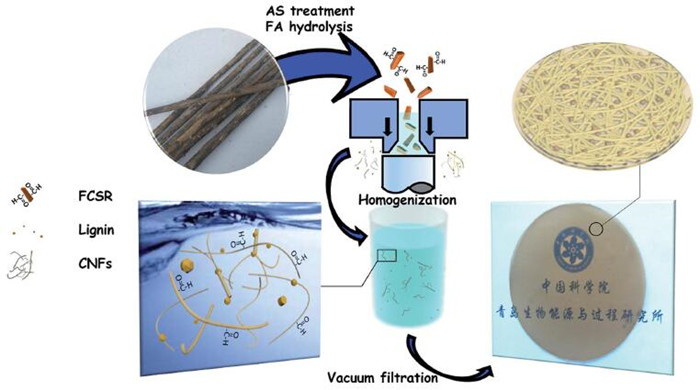
However, CNP is sensitive to moisture due to the hydrophilic nature of cellulose. Absorption of moisture could result in the loss of strength and durability of CNP. These drawbacks limited the usability of CNP under high-moisture environments or in water. To overcome this obstacle, the introduction of expensive building blocks or complicated procedures was usually unavoidable for the fabrication of CNP.
Recently, a research team led by Dr. LI Bin from the Qingdao Institute of Bioenergy and Bioprocess Technology (QIBEBT) of the Chinese Academy of Sciences extracted lignin-containing cellulose nanofibrils (CNFs) via a one-step recoverable organic acid hydrolysis plus homogenization in dimethylacetamide (DMAC). The resultant CNFs were directly used to fabricate strong, flexible, and water resistant CNP without any complex chemical modification.
In the obtained CNP, the residual lignin was found to act as a reinforcing agent between CNFs. Results showed that the tensile strength and toughness of the lignin-containing CNP (255 MPa and 19.7 MJ.m-3) were much higher compared with the one without lignin (179 MPa and 12.8 MJ.m-3).
The water-resistance of CNP was also improved extraordinarily, and its maximum wet tensile strength reached up to 83 MPa, which is the highest value in comparison with reported CNP. Moreover, the fabricated CNP exhibited excellent ultraviolet (UV) blocking ability due to the UV-absorbing functional groups of the residual lignin.
The study, published in Journal of Materials Chemistry A, provides a low-cost, clean and sustainable route for the production of lignin-containing CNP, and the characteristics of the resulting CNP demonstrates its potential use in many fields.
The research was supported by the National Natural Science Foundation of China, the National Science & Technology Pillar Program during the Twelfth Five-Year Plan Period, the Primary Research and Development Plan of Shandong Province, and Shandong Provincial Natural Science Foundation.

Schematic diagram of the preparation of lignin-containing CNP. (Imaged by WANG Qingbo)

86-10-68597521 (day)
86-10-68597289 (night)

52 Sanlihe Rd., Xicheng District,
Beijing, China (100864)

